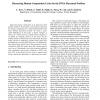Free Online Productivity Tools
i2Speak
i2Symbol
i2OCR
iTex2Img
iWeb2Print
iWeb2Shot
i2Type
iPdf2Split
iPdf2Merge
i2Bopomofo
i2Arabic
i2Style
i2Image
i2PDF
iLatex2Rtf
Sci2ools
ERSA
2009
2009
Harnessing Human Computation Cycles for the FPGA Placement Problem
Harnessing human computation is an approach to find problem solutions. In this paper, we investigate harnessing this human computation for a Field Programmable Gate Array (FPGA) placement problem. We create a game called Plummings. In this game, a player attempts to reduce the critical path of a digital design mapped to an FPGA by swapping clusters on the array, but the details are abstracted away, and instead, the game simply presents a challenging problem where paths must be minimised to save the game characters - the Plummings. Once players have played a level, the placement is can be evaluated in VPR. Our results show that 4 human players over a set of 5 benchmarks can create placement solutions with comparable critical paths compared to VPR's solutions. This is not always the case, and we suggest some reasons and further approaches to improving our results.
| Added | 17 Feb 2011 |
| Updated | 17 Feb 2011 |
| Type | Journal |
| Year | 2009 |
| Where | ERSA |
| Authors | Luke Terry, Vladimir Roitch, Shoeb Tufail, Kirit Singh, Omair Taraq, Wayne Luk, Peter Jamieson |
Comments (0)

